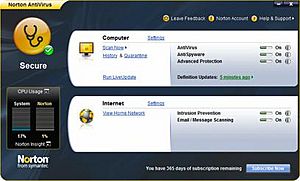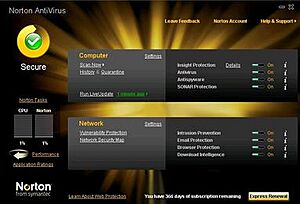Norton AntiVirus facts for kids
| Developer(s) | Gen Digital |
|---|---|
| Initial release | December 1990 |
| Stable release | Windows: 22.21.10.40 (November 1, 2021) |
| Operating system | Microsoft Windows (Windows 95 and later), macOS, Linux |
| Platform | x86, x64 |
| Type | Antivirus |
| License | Commercial proprietary software |
Norton AntiVirus is a special computer program that helps protect your computer from harmful software. This harmful software is often called malware or viruses. It was created by Peter Norton and has been developed by Symantec (now called Gen Digital) since 1990.
Norton AntiVirus is part of a group of computer security products known as the Norton family. It works by looking for specific patterns, like a digital fingerprint, to find known viruses. It also uses smart guesses (called heuristics) to spot new threats. Some versions of Norton AntiVirus can even help filter out unwanted e-mail spam and protect you from phishing scams, which try to trick you into giving away personal information.
You can get Norton AntiVirus in different ways: by downloading it, buying a physical box, or sometimes it comes pre-installed on new computers. It's a very popular security program, used by many people around the world. It works on different computer systems like Microsoft Windows, Linux, and macOS.
Contents
How Norton AntiVirus Started
In May 1989, Symantec launched its first antivirus program for Macintosh computers, called SAM. A newer version, SAM 2.0, came out in March 1990. This version was special because it could be easily updated to find and remove new viruses, even ones that hadn't been created yet!
In August 1990, Symantec bought a company called Peter Norton Computing. Peter Norton's company made useful programs for computers, but they didn't include antivirus features. Symantec decided to keep developing these programs and sell them under the "Norton" name. For a long time, Peter Norton's famous crossed-arm pose was on the product boxes.
Later, in 1998, SAM for Macintosh was renamed to Norton AntiVirus (NAV) for Macintosh, just like the version for Windows computers.
Norton AntiVirus for Windows and DOS
By early 1991, computer viruses were becoming a big problem in the U.S. Symantec's Norton team then launched Norton AntiVirus 1.0 for PC computers. This first version had a small issue where it didn't always fix infected files correctly. This was quickly fixed when version 1.5 was released in June 1991.
Norton AntiVirus 2.0 came out in December 1991. It added a helpful feature: you could create a "rescue disk." This disk could save important information about your computer's hard drive. If a virus messed up this information, the rescue disk could help you get your computer working again.
In September 1993, Norton AntiVirus 3.0 was released. This version had a unique safety feature. If it found a virus trying to load into your computer's memory, it would stop the computer completely. This made sure you could turn off your computer safely and restart it with a clean, virus-free disk. This was the safest way to deal with viruses that tried to hide in your computer's memory. Norton AntiVirus 3.0 was also the first version made for Windows 3.1.
Later versions of Norton AntiVirus added more features. In 2004, a system called Product activation was added to stop fake copies of the software from being used. In 2005, Norton AntiVirus started to detect and remove spyware and adware, which are programs that can track what you do online or show you unwanted ads.
Users of older versions (from 2006 to 2009) could easily update to the newest version without buying a new subscription. This meant they kept the remaining days on their current subscription.
Norton AntiVirus 2009
Norton AntiVirus 2009 was released on September 8, 2008. Symantec made many changes to this version to make it faster and use less of your computer's power. It was designed to have almost no impact on how your computer runs. Tests showed it installed quickly, scanned fast, and used very little memory.
This version made it easier to see your security status and change settings from one main screen. It also showed how much of your computer's processing power Norton was using. A new feature called Norton Insight helped speed up scans by knowing which files were safe. Updates were sent out very often, every 5 to 15 minutes, to help protect against new threats quickly.
Norton AntiVirus 2009 worked on Windows XP Service Pack 2 and Windows Vista. There were also special versions, like a "Gaming edition" that let you control updates better while playing games, and a "Classic edition" that didn't detect spyware or adware.
Norton AntiVirus 2010
Version 17.0 was released on September 9, 2009. This version improved how Norton detected new and unknown threats. It could give users more information about where applications came from and what they were doing. A new feature called Autospy helped users understand exactly what Norton did when it found malware. This was helpful because sometimes older versions would remove threats quietly, which could be confusing.
Norton AntiVirus 2010 also added support for Windows 7. Another new feature, Norton Download Insight, helped prevent harmful programs from downloading onto your computer without you knowing.
Norton AntiVirus 2011 and 2012
These versions continued to improve on speed and protection. They were designed to be very light on your computer's resources, meaning they wouldn't slow it down much. They were also praised for being very good at protecting against viruses and other threats.
Norton AntiVirus 2016 and Later
In 2015, Symantec briefly stopped selling Norton AntiVirus as a separate product, replacing it with "Norton Security." However, they later brought back a basic version called Norton AntiVirus Basic. The software continues to be updated and improved to protect against the latest online threats.
Norton AntiVirus for Mac Computers
Norton AntiVirus 11 for Mac was made to work with Mac OS X v10.5 Leopard. It could find and remove both Mac and Windows viruses. It also had a tool to check for weaknesses in your software that attackers could use. This version could even scan files stored in compressed archives or on Time Capsule backups.
For Mac users who also ran Windows on their computers using programs like Boot Camp, there was a special "Dual Protection" version. This gave them a license for both Norton AntiVirus for Mac and Norton AntiVirus for Windows.
How Norton Compares to Other Software
From 2009 to 2012, Symantec made big improvements to how fast and well their Norton products worked. These versions used very little computer memory and ran smoothly. When a new virus is found, Norton quickly gets information about it (a "virus signature") to help it recognize and remove the threat.
Tests have shown that Norton AntiVirus and Norton Internet Security are among the fastest and lightest security programs available. Many computer magazines and testing groups have also said that Norton products offer strong protection.
See also
 In Spanish: Norton AntiVirus para niños
In Spanish: Norton AntiVirus para niños
- Internet security
- Comparison of antivirus software





